Celebrating Real Bread Week
Anyone who has ever been here to the cooking school will know just how much we love bread making or should that be making Real Bread??
It’s something young and old can get stuck into and you can create a miraculous range of fabulous breads from the most basic of ingredients – flour, salt, yeast and water. Yes you can get a bit nerdy about the process as with most things but essentially that’s all it is, 4 things, and some time.
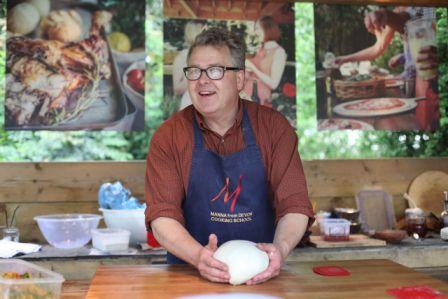
Love Bread Making!
Bread making does seem to be something that divides people – either it’s something they want to get stuck into (literally when some of the doughs are so wet) and others who still shudder at the memories of brick like structures coming from domestic science ovens at school. Here it’s Holly who was put off cooking for a very long time by the cookery teachers at her girls’ grammar school and pushed towards other rather more literary subjects; while David was (and still is) very proud of his cookery ‘O’ level taught by the inspirational and aptly named Mrs Bun.
We think bread making could justifiably be a school project making many subjects come alive; how about
- chemistry, physics and biology (it’s a scientific process with actions and reactions using live yeast)
- social geography and history (you can track the movement of breads like the bagel from Jewish communities in eastern Europe in the 17th Century to mainstream America in the 20th Century and now into Japan)
- mathematics (bakers use a lot of percentages and calculations)
- and art (creating something desirable)
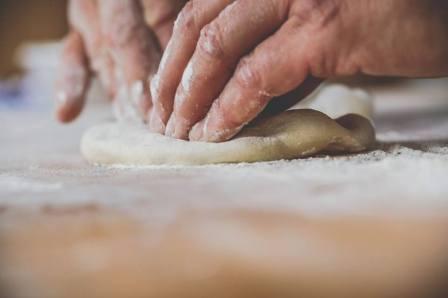
Getting hands on
We are really lucky in Dartmouth to have two great bakeries here in town as well as the Deli at Dartmouth in Duke Street bringing in fantastic sourdough bread from the Almond Thief bakery in Dartington.
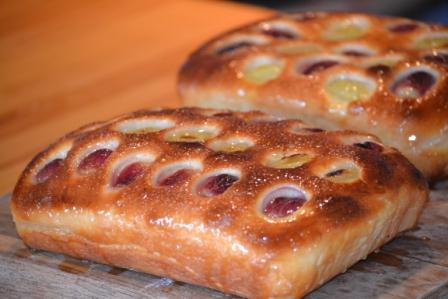
Another favourite – sweet schacchiata with grapes
We and our students make a fair few pizzas here at the cooking school during our wood fired cooking courses – and they are amazing. However there is so much more to flat breads than just pizzas which you can make with the same dough. An all time favourite is the Provencal pissaladiere reminiscent of hot days with a glass of very cold rosé wine and enjoying a piece of oily bread topped with slow-cooked sweet onions, salty anchovies and olives.
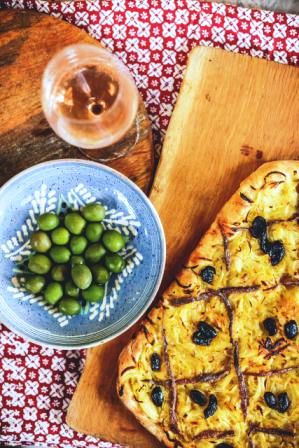
Pissaladiere – an all time favourite
Or maybe another close favourite would be the eastern European Khachapuri. Coming from Georgia it’s a popular Russian street food with a few glasses of vodka however a perfect choice and one we serve for brunch as it’s full of egg and cheese with optional mushrooms and ham.
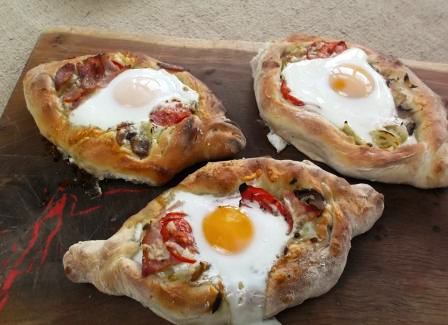
Khachapuri – perfect for brunch
Or another close choice, the Catalonian coca – like a pizza but no cheese or tomatoes and brings back memories of travelling in Barcelona and northern Spain every time.
Amongst many things that surprise our students is how soft and initially wet the bread dough is. It is really tempting to add more flour to a soft and sticky dough but if you do, the final bread will be solid and dense instead of light, pillowy and inviting. Also a long slow rise is good for flavour and texture – not the hour in a warm place, advised by many older recipes; when it’s ready it’s ready. You can even leave it overnight in a fridge if you don’t want to get up at sparrow o’clock to make the dough.
If you’re tempted to have a go, then just have a go – nothing gives you the experience and confidence that your own bread making will. You can make a huge variety of breads from just one basic dough and
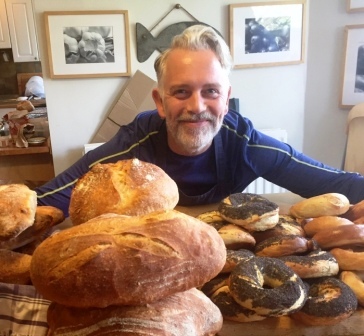
What a selection!
no more heavy duty, solid school-cooking bricks; good bread is definitely the way ahead!
Here’s our basic recipe used to make the afore-mentioned khachapuri.
Khachapuri (Georgian Cheese filled Boat)
These are fun to make and very filling, great for feeding a hungry crowd. We mix three cheese, mozzarella for stringiness, mature cheddar for sharpness and feta for saltiness. Nothing like the original Georgian mixture but let’s not allow a lack of authenticity get in the way of a good snack.
For 4 Khachapuri:
- 400g strong white or ’00’ flour
- 4g fast acting yeast
- 8g salt
- 260g room temperature water
- 100g grated mozzarella
- 100g grated mature cheddar
- 100g crumbled feta
- 4 medium eggs
- Olive oil
- 2 tsp chopped fresh thyme or 1 tsp dried thyme.
- Mix the flour and yeast. Add the water and mix. . Cover and leave for 30 minutes.
- Add the salt, mix well then knead the dough until smooth and springy. Try not to add more flour as it will dry out eventually. Cover and leave to mature for 2 hours.
- Meanwhile mix the mushrooms with a good glug of olive oil and the thyme and leave aside. Mix the three cheeses and leave in the fridge.
- Divide the dough into 4 even sized pieces. Shape into balls, cover with oiled clingfilm and leave to rest for 30 minutes. This will make shaping the breads much easier.
- Heat your oven to 250C or as hot as it will get and put two baking sheets in the oven.
- Take a ball of dough and place in on a floured surface. Sprinkle a little flour on top.
- Use your fingertips to press the dough out to make a rounded rectangle approx. 30x15cm.
- Take two corners at one end and cross one over the other. Press down to create the bow of your boat. Repeat at the other end to make the stern.
- Roll the edges in and press down to make the gunwales of your boat. You should know have a nice, deep pocket to fill with mushrooms and cheeses.
- Put in a shallow layer of mushrooms and a piled up layer of cheeses. Do the same to create another 3 khachapuri.
- Take each sheet out of the oven and carefully place 2 khachapuri on each one. Bake for about 10 minutes. The sides and ends should be well risen and puffy and the cheeses bubbly and browned.
Optional – Halfway through baking push aside the cheese to make a well and crack in a medium sized egg. Continue cooking until the egg is almost done; it will finish cooking on the heat of the cheese.
If you’d like to find out more about our bread making especially in our wood fired ovens, you can buy our new book Wood Fired Flat Breads & Pancakes here
Happy Baking!

